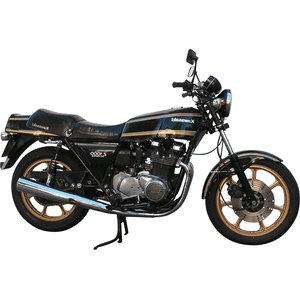Kawasaki Z 1000 (2014-2017): A Sugomi-Inspired Streetfighter Test Ride

Introduction
The Kawasaki Z 1000 (2014-2017) isn’t just a motorcycle—it’s a declaration of war against blandness. Dubbed the “Sugomi” generation, this naked bike channels the primal energy of a predator poised to strike. With its aggressive stance, howling inline-four engine, and razor-sharp handling, the Z 1000 redefined the streetfighter segment. After a spirited test ride, it’s clear why this machine remains a cult favorite among riders who crave raw power and visceral design.
Design & Styling: Predatory Aesthetics
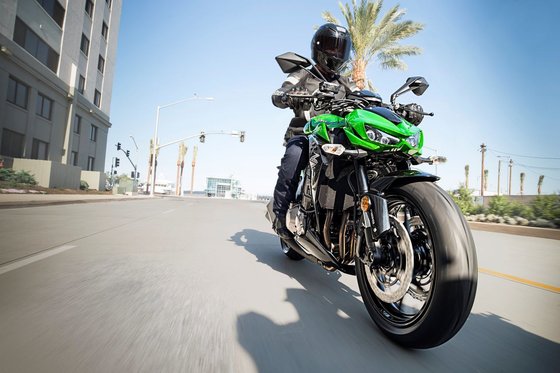
Kawasaki’s “Sugomi” philosophy—a Japanese term describing the aura of a crouching beast—is evident in every angle. The Z 1000’s design is unapologetically bold:
- LED Lighting: The reflector-less LED headlight cluster (a first for Kawasaki) emits a menacing glare, complemented by a slim LED taillight.
- Muscular Proportions: The 17-liter (4.5 US gal) fuel tank flares aggressively, while the underbelly cowl and radiator shrouds emphasize mechanical brutality.
- Color Schemes: Options like Golden Blazed Green/Metallic Spark Black and Candy Burnt Orange/Flat Ebony amplify its street presence.
The aluminum twin-tube frame isn’t just functional—it’s art. Cast as a single unit with the swingarm pivot, it blends rigidity with minimalist elegance. Even the seat’s textured “Z” motif feels deliberate, like a brand marking its territory.
Engine & Performance: Unleashing the Beast
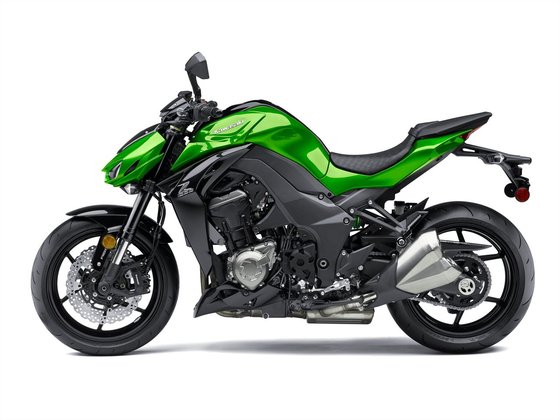
At the heart lies a 1,043cc inline-four engine, tuned for street dominance:
- Power Delivery: 142 HP (103.6 kW) @ 10,000 RPM and 111 Nm (81.9 ft.lbs) @ 7,300 RPM. The mid-range torque is addictive, pulling hard from 4,000 RPM without plateauing.
- Intake Symphony: Downdraft Keihin throttle bodies and velocity stacks create an intoxicating howl. At full tilt, it’s a mix of mechanical snarl and primal roar.
- Exhaust Note: The 4-into-2-pre-chamber-into-2 exhaust system barks on acceleration, while a butterfly valve muffles low-RPM drone.
The assist-and-slipper clutch (added in 2016) reduces lever effort by 30%, making city riding tolerable. Short gearing rockets you off the line, but the tall 6th gear keeps highway cruising at 4,500 RPM—smooth, but never sleepy.
Handling & Dynamics: Precision Meets Playfulness
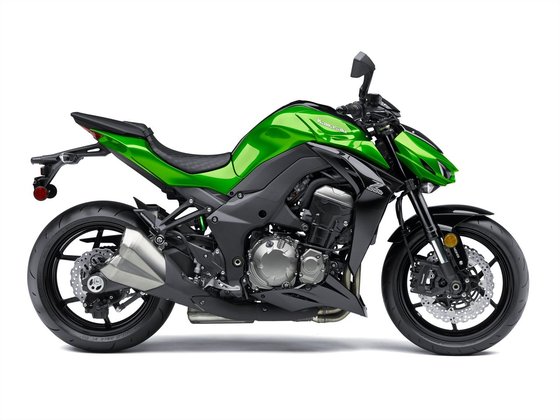
Kawasaki borrowed chassis DNA from the Ninja ZX-10R, resulting in a 221 kg (487 lbs) package that feels lighter than its specs suggest:
- Suspension: The 41mm Showa SFF-BP inverted fork balances comfort and feedback. Out back, the horizontal back-link monoshock handles bumps without wallowing.
- Brakes: Radial-mount monobloc calipers bite 310mm petal discs up front. ABS (optional until 2015, standard thereafter) intervenes subtly, even during hard stops.
- Tires: 120/70-ZR17 front and 190/50-ZR17 rear Bridgestones offer grip for aggressive leans, though cold mornings demand caution.
The 24.5° rake and 104mm trail make flicking through corners intuitive. It’s not as telepathic as a supersport, but the Z 1000 rewards aggression with precision.
Ergonomics & Comfort: Streetfighter Practicality
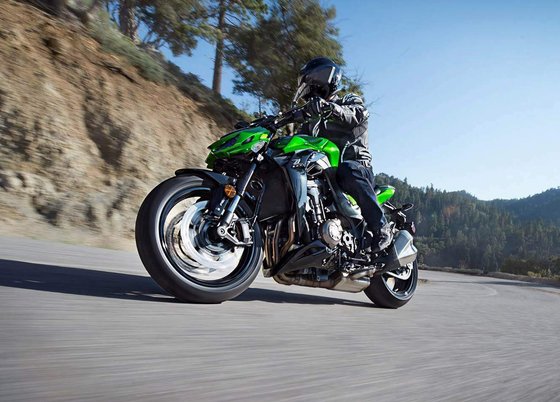
The Z 1000’s riding position splits the difference between sport and street:
- Seat Height: 815mm (32.1 inches) is accessible for most riders, though the narrow waist helps shorter inseams.
- Handlebar: Wide, aluminum bars offer leverage for quick direction changes. Vibration is minimal, even at triple-digit speeds.
- Footpegs: Knurled and rear-set, they scrape early but remind you to respect the bike’s limits.
Long rides? The seat firms up after an hour, but windblast at 130+ km/h (80+ mph) is the real limiter. This isn’t a tourer—it’s a backroad bruiser.
Competition: How the Z 1000 Stacks Up
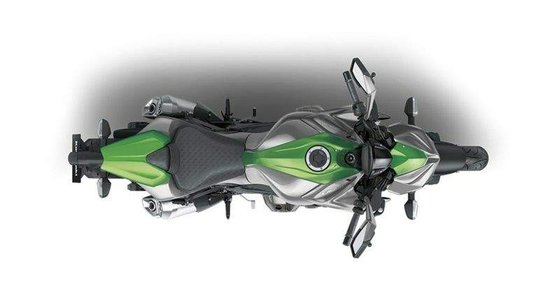
Yamaha MT-10
- Pros: Crossplane crankshaft growl, advanced electronics (Traction Control, Ride Modes).
- Cons: Softer suspension, polarizing design.
- Verdict: The MT-10 is tech-savvy, but the Z 1000 feels rawer and more visceral.
Suzuki GSX-S1000
- Pros: Smooth power delivery, lower price.
- Cons: Dated styling, less cornering clearance.
- Verdict: A budget-friendly alternative, but lacks the Z’s “Sugomi” edge.
Ducati Monster 1200
- Pros: Italian flair, torquey L-twin.
- Cons: Steep maintenance costs, cramped ergonomics.
- Verdict: The Ducati excels in exclusivity, but the Z 1000 offers more bang-for-buck.
Maintenance: Keeping the Beast Alive
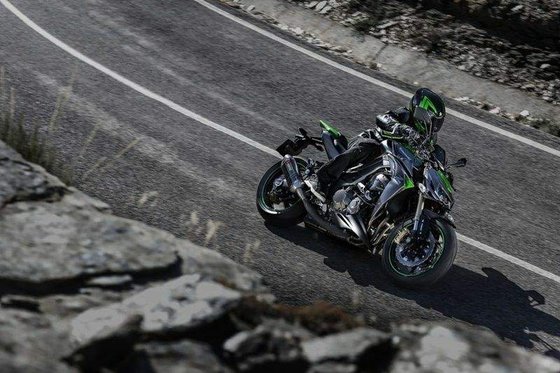
The Z 1000 is robust but demands attention to detail:
- Oil Changes: Use 3.8L of SAE 10W-40 (API SG+) every 6,000 km (3,700 miles). Consider MOTOPARTS.store’s synthetic blends for hotter climates.
- Chain Care: The X-ring chain needs cleaning every 500 km (310 miles). A DID chain kit ensures longevity.
- Brake Fluids: Flush DOT 4 fluid biennially. Upgrade to braided lines for firmer lever feel.
- Coolant: Replace 2.9L every 2 years. Kawasaki’s OEM coolant prevents aluminum corrosion.
- Spark Plugs: NGK CR9EIA-9 iridium plugs last 24,000 km (15,000 miles). Check gaps at 0.8–0.9mm.
- Tire Pressure: 2.5 bar (36 psi) front / 2.9 bar (42 psi) rear. Overinflation dulls grip; underinflation accelerates wear.
Conclusion: A Modern Classic
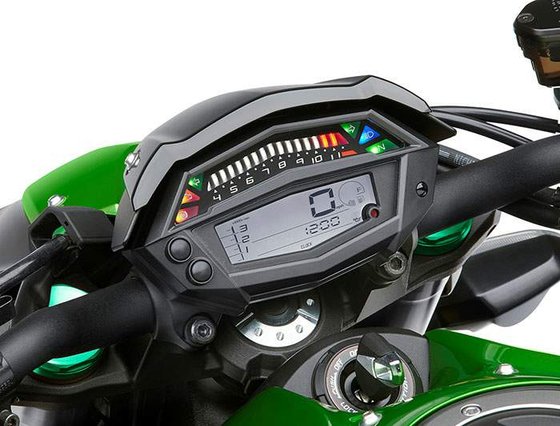
The 2014–2017 Z 1000 isn’t perfect—it’s thirsty, lacks rider modes, and its ABS is rudimentary by today’s standards. But perfection isn’t the point. This bike thrives on analog thrills: the way the engine howls at redline, the chassis telegraphs every ripple in the asphalt, and the design dares you to ride harder.
For owners looking to personalize their Z 1000, MOTOPARTS.store offers upgrades like slip-on exhausts, rearsets, and suspension kits. Because even predators deserve a sharper set of claws.
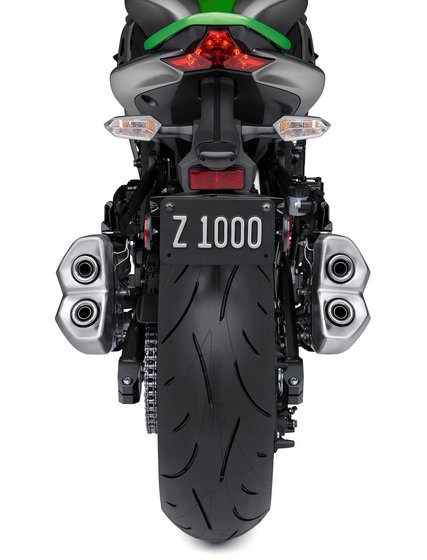




Specifications sheet
| Engine | |
|---|---|
| Clutch: | Wet multi-disc, manual |
| Stroke: | Four-stroke |
| Max power: | 104 kW | 139.0 hp |
| Max torque: | 111 Nm |
| Fuel system: | Fuel Injection (DFI with 38mm Keihin throttle bodies, oval sub-throttles) |
| Max power @: | 10000 rpm |
| Displacement: | 1043 ccm |
| Max torque @: | 7300 rpm |
| Bore x stroke: | 77.0 x 56.0 mm (3.0 x 2.2 in) |
| Configuration: | Inline |
| Cooling system: | Liquid |
| Compression ratio: | 11.8:1 |
| Number of cylinders: | 4 |
| Valves per cylinder: | 4 |
| Dimensions | |
|---|---|
| Wheelbase: | 1435 mm (56.5 in) |
| Wet weight: | 221 |
| Seat height: | 815 mm (32.1 in) |
| Overall width: | 790 mm (31.1 in) |
| Overall height: | 1055 mm (41.5 in) |
| Overall length: | 2045 mm (80.5 in) |
| Ground clearance: | 125 mm (4.9 in) |
| Fuel tank capacity: | 17 L (4.5 US gal) |
| Drivetrain | |
|---|---|
| Final drive: | chain |
| Gear ratios: | ['1st 2.600', '2nd 1.950', '3rd 1.600', '4th 1.389', '5th 1.238', '6th 1.107'] |
| Transmission: | 6-speed |
| Rear sprocket: | 43 |
| Front sprocket: | 15 |
| Final reduction ratio: | 2.800 (43/15) |
| Maintenance | |
|---|---|
| Chain type: | X-Ring sealed chain |
| Engine oil: | 10W40 |
| Brake fluid: | DOT 4 |
| Spark plugs: | NGK CR9EIA-9 |
| Spark plug gap: | 0.8-0.9 mm |
| Coolant capacity: | 2.9 |
| Forks oil capacity: | 1.2 |
| Engine oil capacity: | 3.8 |
| Engine oil change interval: | Every 5000 km or 2 years |
| Valve clearance (intake, cold): | 0.10–0.20 mm |
| Valve clearance check interval: | 24,000 km (15,000 mi) |
| Valve clearance (exhaust, cold): | 0.20–0.30 mm |
| Recommended tire pressure (rear): | 2.9 bar (42 psi) |
| Recommended tire pressure (front): | 2.5 bar (36 psi) |
| Additional Features | |
|---|---|
| ABS: | True |
| Lighting: | Reflector-less LED headlight |
| Warranty: | 12 months (factory) |
| Instrumentation: | Digital LCD with tachometer, ECO mode, and fuel consumption data |
| Chassis and Suspension | |
|---|---|
| Rake: | 24.5° |
| Frame: | Aluminum twin-tube/backbone |
| Trail: | 103 mm (4.0 in) |
| Rear tire: | 190/50-z-17 |
| Front tire: | 120/70-z-17 |
| Rear brakes: | Single 250 mm petal disc, 1-piston caliper (ABS) |
| Front brakes: | 2 x 310 mm petal discs, radial-mount 4-piston monobloc calipers (ABS) |
| Rear suspension: | Horizontal back-link monoshock with stepless rebound damping and preload adjustability |
| Front suspension: | 41 mm inverted SFF-BP fork with stepless compression/rebound damping and spring preload adjustability |
| Rear wheel travel: | 122 mm (4.8 in) |
| Front wheel travel: | 120 mm (4.7 in) |



